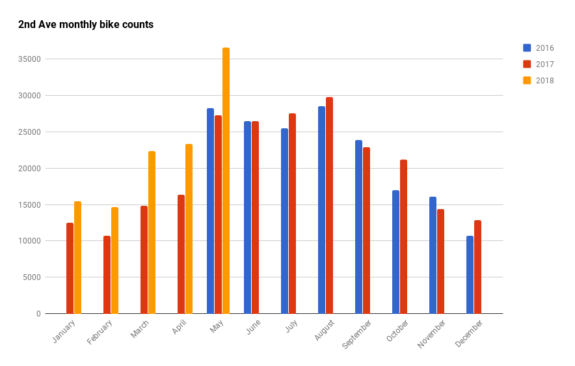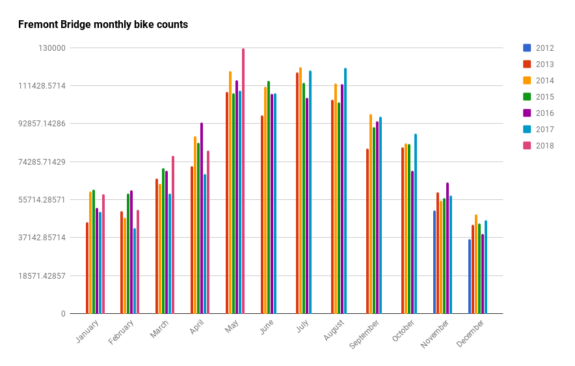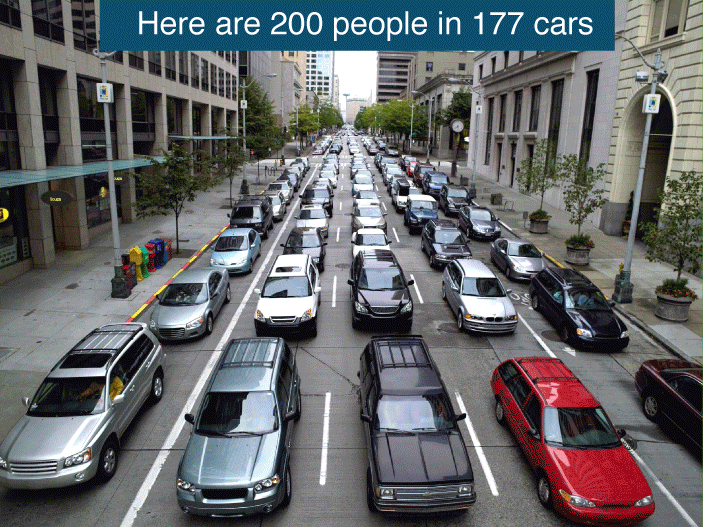 The number of people biking on 2nd Ave in downtown Seattle is up an average of 19 percent year-over-year since the July 2017 launch of private bike share services. And the trend appears to have accelerated as SDOT opened a vital extension of the 2nd Ave bike lane through Belltown in January and companies added more shared bikes throughout fall 2017, eventually reaching 10,000 by the end of the year.
The number of people biking on 2nd Ave in downtown Seattle is up an average of 19 percent year-over-year since the July 2017 launch of private bike share services. And the trend appears to have accelerated as SDOT opened a vital extension of the 2nd Ave bike lane through Belltown in January and companies added more shared bikes throughout fall 2017, eventually reaching 10,000 by the end of the year.
So far in 2018, 2nd Ave bike counts are up an astounding 37 percent. These increases are far beyond the expected year-to-year variations due to weather or special events.
The combination works. When the city builds downtown bike lanes that more people feel safe using and people have convenient access to bike share, more people will bike.
Seattle has all these pieces working together right now. All the city needs to do is keep it going. Keep adding more connections to the downtown bike network, and keep working with private companies innovating ways to improve access to bikes. Every time the city makes a new connection, the whole downtown bike network becomes more useful for more trips.
And private bike share companies, operating at no cost to the city, are like adding carbon-free fuel to that fire by dramatically increasing the number of people who can take advantage of these new bike lanes. People across the region no longer need to get their own bikes downtown in order to bike there. In a recent survey, about three of four bike share users reported using the bikes to access transit. The bike network and bike share and working together with transit to move people to and through downtown.
But new bike lane connections that should be under construction right now are delayed, as Mayor Jenny Durkan’s administration has pushed back key bike lanes in the near-term plan to improve mobility downtown by several years. People clearly want to bike downtown, but a single safe street just is not enough.
Without building new connections, biking will only grow by so much. With a possible downtown traffic nightmare looming, Seattle needs to do all it can to give people options other than driving. One extra general purpose lane on 4th Ave will do nothing to help car traffic, but a protected bike lane on 4th Ave would dramatically improve bike access to a very dense corridor of jobs and destinations. Bike lanes are highly efficient, but only if there is a usable network that people can easily access. Seattle’s almost there. This is no time to turn back.
These images were true for 2nd Ave, and they’re true for 4th Ave, too. And Rainier Ave. And Eastlake Ave and Wilson Ave S and 35th Ave NE:
So, is the increase in 2nd Ave biking happening elsewhere in the city? Yes, but not quite to the same extent.
 The Fremont Bridge counter absolutely crushed the all-time monthly biking record last month, topping the previous record-holder by eight percent. Year-over-year, biking is up 14 percent since the launch of bike share and up 20 percent so far in 2018.
The Fremont Bridge counter absolutely crushed the all-time monthly biking record last month, topping the previous record-holder by eight percent. Year-over-year, biking is up 14 percent since the launch of bike share and up 20 percent so far in 2018.
How much all this can be attributed to bike share is hard to say. Some of it is that 2017 got off to a very slow start, so year-over-year comparisons are a little inflated. But the increase is large enough that it almost certainly points to a cause beyond just weather variation and special events. In fact, some of the big late summer counts happened despite all that nasty wildfire smoke that brought poor air quality to the city for an extended period of time.
Bike share companies combined did not reach 10,000 bikes on the ground until the dead of winter, so we are just now seeing the power of a decently-established bike share system during warm weather months when biking typically balloons. And it’s beautiful.
As the city looks to update its bike share permit, we should be focusing on how to improve and grow the benefits of these bike services. Because their success at increasing the number of trips by bike would also be the city’s success at a time when Seattle needs such a mode shift the most. Private bike share is like sustainable and efficient transportation manna falling from heaven, but the city needs to build more bike lanes to catch it.









Comments
18 responses to “Biking on 2nd Ave downtown is up 37% as bike share and bike lanes expand”
Is the growth normalized with population growth?
How are you getting these bike counter graphics? The webpages haven’t worked for me for a while.
https://www.seattle.gov/transportation/projects-and-programs/programs/bike-program/bike-counters
Where did the data come from? how did they measure it? I am a cyclist and I used to love 2nd Avenue. I despise the BLOD of the PBL.
Does anyone read this stuff besides us bike nerds? It seems unlikely that any of these beautiful facts will ever come to the attention of the people who actually make decisions about where concrete gets poured.
To add to JB’s comment, I would love to see this headline in the Seattle Times instead of the usual negative articles they run about bike lanes. Anybody have a contact over there?
We did get a headline recently.
https://www.seattletimes.com/opinion/seattle-must-deliver-on-promised-transit-sidewalk-and-bike-projects/
I really don’t have a problem with the current 4th Ave bike lane but I can see how it wouldn’t be ‘all ages and abilities’ acceptable.
Speaking of 4th, I was initially happy when they raised the bike lane to sidewalk level under the Yesler overpass because cars would often cut that curve putting a cyclist in an uncomfortable squeeze against the wall. Now I wish they had left it alone. The bike lane is more often than not blocked by people, tents, trash, and even human excrement. I know it makes me a heartless monster to even point this issue out but the same people we are hoping to attract with a more accessible bike lane design will be just as dissuaded by the uncomfortable, dangerous conditions on the bike-lane-turned-sidewalk as the uncomfortable, dangerous conditions on the street.
So if we are going to redo 4th I hope that issue is addressed. Would the bike lane move to the other side of the street? Seems like it will be pretty tight under Yesler.
I don’t really have an issue with the current 4th either or non-protected bike lanes/shoulders in general (in fact if we can speed up the process by just painting these all over the place and worrying about protected lanes later, that would be a more optimal solution), but the shoulder is cut off on Spring and there’s that large metal grating just before and after pike which is VERY slippery in the wet..
I think the bigger appeal to the work on 4th is the ability to go south down it (two-way) rather than just the protection/barriers in of itself
I rode 2nd Ave PBL this morning and it was awesome, not perfect but the signals worked well and the new part is smoother than the older downhill section. Build more PBL’s ASAP!!!!
Wait til you hit the signals heading north. Its agonizing, but I guess you can’t make it work both directions.
Agreed about northbound. I always take Western or 4th. It’s just too frustrating to wait every two blocks, sometimes every block. But, hey, it’s much safer than before and I hope the result is more passive riders are willing to ride than before.
It’s still better than the way it used to be, when you couldn’t bike northbound on 2nd at all. The red lights give you a chance to rest your legs during the climb.
Eve with the slow going north bound, I still love the safety of the 2nd Ave PBL. The time delay of the stop-and-go stoplights when traveling north bound on 2nd are another reason we need a parrallel PBL on 4th. They are complementary, and building them both will have a huge increase in comfort and safety when riding downtown.
wait until you start noticing cars turning left on red while the bike signal is green
[…] Build it and they will come: Biking on Second Avenue in Downtown Seattle is up 37%. […]
[…] Biking on 2nd avenue is way up […]
Hello, you refer to the bikeshare companies as “carbon-free.” I’m curious how they are able to manufacture thousands upon thousands of disposable bikes overseas and ship them to the USA all without creating any carbon pollution. Care to elaborate?
Please don’t be that person. I’m sure you’re capable of great things. Your argument is nothing close to even a bad thing. It’s a non-thing.